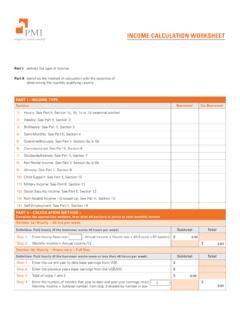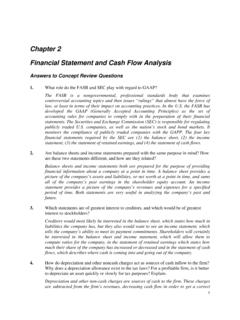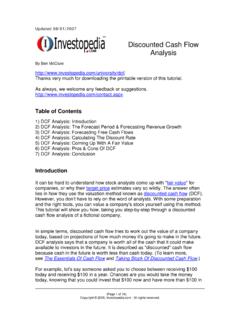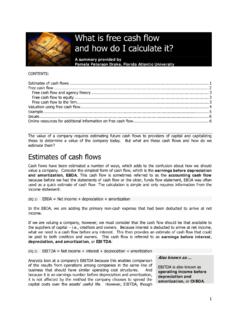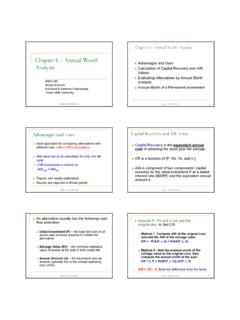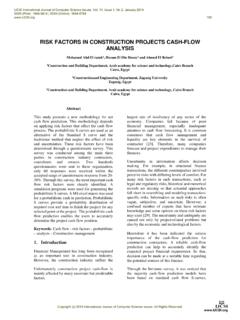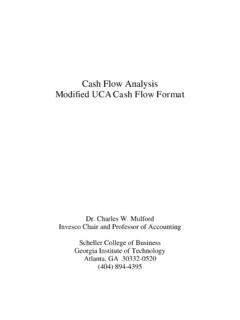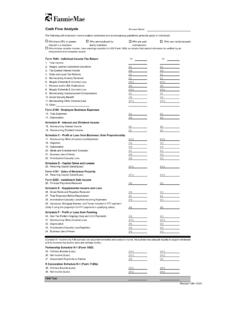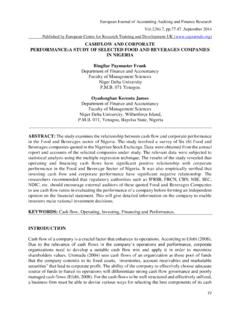Transcription of CASH - FLOW ANALYSIS - SAM Method
1 Borrower and Co-Borrower Name: CASH - FLOW ANALYSIS - SAM MethodDate:I FORM 1040 - PAGE 1 201020091 Self-Employed Wages or Variable Income ( , Commissions):2 Tax-Exempt Interest: 3 Alimony Received: 4 IRA Pension/Annuity Distributions:5 Recurring Unemployment Compensation:6 Social Security Benefits:7 Other Income:8 Other:II FORM 2106 - EMPLOYEE BUSINESS EXPENSES9 Total Expenses:()()10 Depreciation:11 Business Miles: * Miles:**11a 2009: $ 2010: $ SCHEDULE B - INTEREST AND DIVIDENDS 12 Recurring Interest Income:13 Recurring Dividend Income:IV SCHEDULE C - SOLE PROPRIETORSHIP 14 Net Profit (or Loss):15 Nonrecurring Other (Income) Loss or Expenses:16 Depletion:17 Depreciation:18 Meal and Entertainment Exclusion:()()19 Business Use of Home:20 Business Miles: * Miles:**20a 2009: $ 2010: $ Amortization/Casualty Loss:V SCHEDULE D - CAPITAL GAINS AND LOSSES 22 Recurring Capital Gains:23 Recurring Capital Loss:()()VI FORM 6252 - INSTALLMENT SALE INCOME 24 Principal Payments:VII SCHEDULE E - SUPPLEMENTAL INCOME AND LOSS 25 Gross Rents and Royalties Received:26 Amortization/Casualty Loss:27 Total Expenses Before Depreciation:()()28 Insurance, Mortgage Interest and Taxes included in PITI.
2 VIII SCHEDULE F - FARM INCOME 29 Net Profit (or Loss):30 Non-Tax Portion Ongoing Co-op & CCC Pmts:31 Nonrecurring Other (Income) or Loss:32 Depreciation:33 Amortization/Casualty Loss/Depletion:34 Business Use of Home:IX PARTNERSHIP SCHEDULE K-1 (FORM 1065-K1)35 Ordinary Income (Loss):36 Net Income (Loss):37 Guaranteed Payments to Partner:X SCHEDULE K-1 (FORM 1120S-K1)38 Ordinary Income (Loss):39 Net Income (Loss):SUB-TOTAL OF INCOME FROM PERSONAL RETURNS This worksheet is intended to help you analyze self-employed borrowers. Any income or loss obtained from the respective forms and schedules listed in the cash-flow ANALYSIS should be reviewed to determine whether the source was appropriate, can be considered ongoing and consistent and meets investor considering using income from a Partnership, S Corporation or Regular Corporation, it is important to determine the viability of the business as well as the applicant's ability to access funds if they will be used to qualify.
3 In addition, check your investor's requirements. XI PARTNERSHIP201020091 Passthrough (Income) Loss from Other Partnerships:2 Nonrecurring Other (Income) Loss:3 Depreciation: 4 Depletion:5 Amortization/Casualty Loss:6 Mortgages or Notes Payable in Less Than 1 Year:()()7 Travel and Entertainment Exclusion:()()8 Subtotal9 Multiplied by Ownership Percentage% = Partnership Total_____When considering using income from a Partnership, S Corporation or Regular Corporation, it is important to determine the viability of the business as well as the applicant's ability to access funds if they will be used to qualify.
4 In addition, check your investor's requirements. CASH - FLOW ANALYSIS - SAM MethodPartnerships, S Corporations and Regular Corporations:XII S CORPORATION10 Nonrecurring Other (Income) Loss:11 Depreciation: 12 Depletion: 13 Amortization/Casualty Loss:14 Mortgages or Notes Payable in Less Than 1 Year:()()15 Travel and Entertainment Exclusion:()()16 Subtotal17 Multiplied by Ownership Percentage% = S Corporation Total_____XIII REGULAR CORPORATION18 Taxable Income:19 Total Tax:()()20 Nonrecurring (Gains) Losses:21 Nonrecurring Other (Income) Loss:22 Depreciation: 23 Depletion: 24 Domestic Production Activities Deduction.
5 25 Amortization/Casualty Loss:26 Net Operating Loss and Special Deductions:27 Mortgages or Notes Payable in Less Than 1 Year:()()28 Travel and Entertainment Exclusion:()()29 Subtotal30 Multiplied by Ownership Percentage% _____31 Dividends Paid to Borrower:()()32 Regular Corporation Total* TOTALS33 PERSONAL TAX RETURN (FORM 1040)34 PARTNERSHIP, S CORPORATION AND REGULAR CORPORATION SECTIONS35 GRAND TOTAL The income on a profit-and-loss statement may only be considered if it is in line with the previous year's earnings (or submitted through audited statements.) YEAR-TO-DATE PROFIT-AND-LOSS STATEMENT Salary / Draws to Individual Net ProfitX%= Total Allowable Addbacks or DeductionsX%= Year-to-Date TotalComments / Notes:This worksheet is intended to help you analyze self-employed borrowers.
6 Any income or loss obtained from the respective forms and schedules listed in the cash-flow ANALYSIS should be reviewed to determine whether the source was appropriate, can be considered ongoing and consistent and meets investor requirements. Schedule ANALYSIS Method - SAM Primary Qualifying Income (1040 - Personal Tax Return ANALYSIS ) 20102009 SAM Total Income Monthly Average by Year 24-Month Average (2010-2009)Borrower and Co-Borrower Name: Self - Employed Borrower - ANALYSIS Summary Corporations and Partnerships Secondary Income Sources: Some or all of this income may be available for qualifying purposes.
7 Consult your underwriting guidelines. 20102009 Partnership Total S Corporation Total Regular Corporation Total Sum of Partnership, S Corporation, and Regular Corporation Totals Monthly Average by Year 24-Month Average (2010-2009)This worksheet is intended to help you analyze self-employed borrowers. Any income or loss obtained from the respective forms and schedules listed in the cash-flow ANALYSIS should be reviewed to determine whether the source was appropriate, can be considered ongoing and consistent and meets investor requirements.
